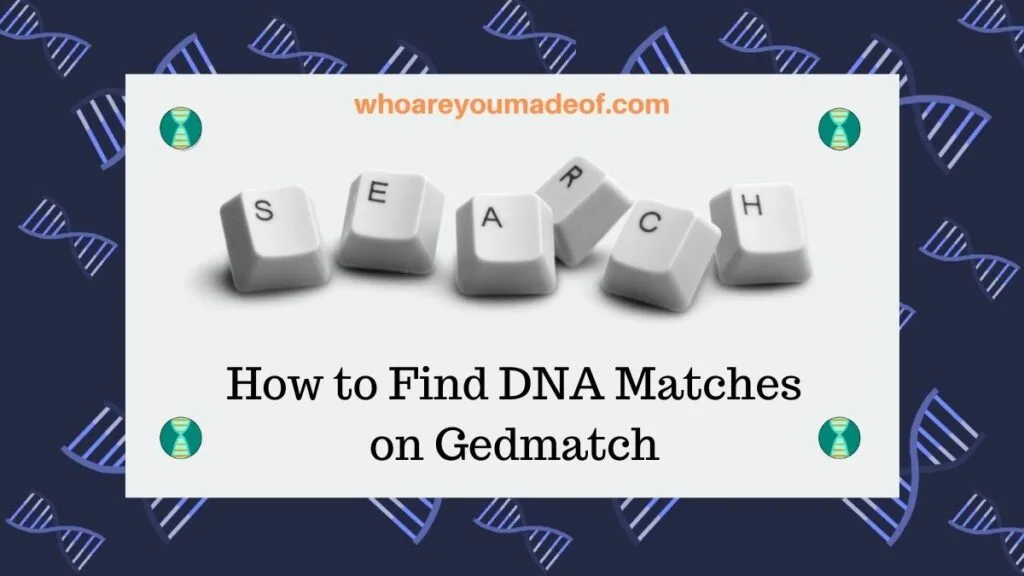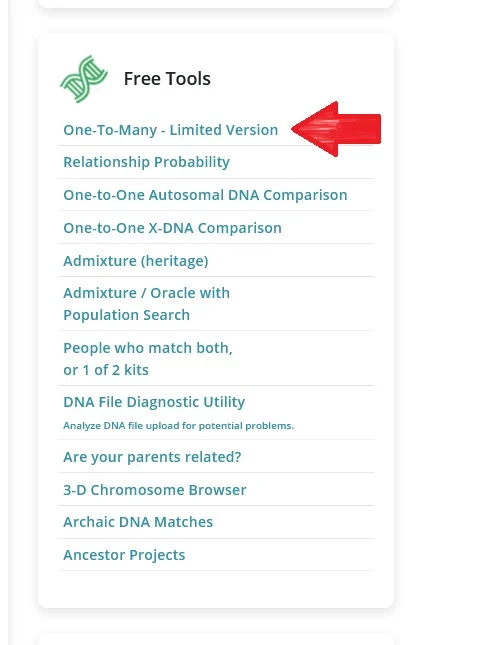If you want to know how to find DNA matches on Gedmatch, you have come to the right place. Gedmatch is a great place to find DNA matches who did their DNA tests with other testing companies.

In this post, you'll learn:
- What you'll need to do before you can get Gedmatch DNA matches
- How to find DNA matches on Gedmatch
- Basics on how to understand your Gedmatch results
I'm a very big fan of Gedmatch, the free website with many useful DNA analysis tools. I hope that this post helps you get started using the site and that you enjoy it as much as I do.
Who can get DNA matches on Gedmatch?
You can get DNA matches on Gedmatch if you:
- Have done an autosomal DNA test
- Can download your DNA information into a file that is compatible with the software on the Gedmatch site
- Upload your DNA file to Gedmatch
Almost all of the major DNA testing companies allow you to download your DNA into a file that can be kept on your computer or uploaded to other websites. This includes Ancestry DNA, 23andMe, Family Tree DNA, Living DNA, and My Heritage.
In order to get your DNA matches from Gedmatch, you will need to go through the process of downloading your DNA from your DNA testing company and uploading it to Gedmatch. You should be able to complete the process in less than 30 minutes.
If you need help uploading to Gedmatch, check out this post:
How to find DNA matches on Gedmatch
Once your DNA is uploaded and your kit has been processed, you can now quickly access your DNA match list. This information will be available in the "One to Many" tool under the "Free Tools" section on your main dashboard.
It says "Limited Version" after the name of the tool on the list if you are using a free account.
You can access the One-to-Many tool on Gedmatch from the main screen that you see after logging in to the site. In the image below, you can see exactly where to click to find the application ; it's the first one on the Free Tools list:

On the tool page, you can enter in your kit number and adjust several options, depending on your specific requirements. Typically, the default settings are adequate for what most of us what to know:
Who are our closest relatives on Gedmatch?
The default settings will provide us a list of the 50 top DNA matches on Gedmatch. For most people, that is plenty to start with, but you can adjust the number to provide the top 100, 500, 1000, or even 3000 matches.
To get more DNA matches on your Gedmatch One-to-Many results, click the down arrow where it says "with this limit" and you see "50" in the drop-down menu, as shown in the image below:

Once you have decided how many people you would like to be on your DNA match list on Gedmatch, just click the "Search" button. To get basic tips to understand your Gedmatch DNA matches, keep reading this post.
If you want to get more than 3000 people on your DNA match list (5000, 10,000 or even 100,000), you will have to upgrade your account to a Tier 1 membership.
How to understand your Gedmatch DNA matches results
Your Gedmatch DNA matches will be presented to you in a list that looks something like a spreadsheet. There are various columns, some that you might find more interesting than others.
The most important columns that beginners should take note of on the Gedmatch DNA match results (the One to Many list) are noted below.
The kit number of your DNA match in the number assigned to a person when they upload their DNA information. If you find a DNA match that is interesting to you, you should make a note of their kit number.
The name (or alias) of your DNA match, as well as their e-mail address, will the way that you get in touch with your DNA match, should you decide to do so. Contacting your DNA matches is a great way to learn a lot about your family tree and closer biological family.
One of the easiest ways to figure out how you are related to your Gedmatch DNA match is by viewing their GEDCOM or Wikitree, if they have one attached to their Gedmatch profile. If they do, there will be a link to their tree in the GEDCOM or Wikitree column.
In order to know how far back you should look in your DNA match's family tree for your connection, you should check out the Total cM column. Using this information, you can read my post "Beginner's Guide to Shared Centimorgans" to learn how you can use this information to learn how you might be connected to your match.
Gedmatch does estimate the number of generations back to the most recent common ancestor using the Total cM number and the Largest (cM) information. This information is only an estimate, but you can view it in the Gen column.
If you want to know which testing company your DNA match on Gedmatch originally tested with, you can find it in the Source column. If it says "migration" along with some other data, then this means that your match uploaded their DNA to the "old" Gedmatch site and it was migrated to the new Gedmatch site. Newer uploads will list the name of the company that did the initial DNA test.
To learn even more about how to understand your Gedmatch DNA matches, read this post:
Conclusion
I hope that this post has helped you understand what you'll need to do to find your DNA matches on Gedmatch, and how to understand your Gedmatch DNA match list.
If you have any questions about something that you read in this post, or if you would like to share your own experience finding DNA matches on Gedmatch, please join us in the discussion below.
Thanks for stopping by!

John Teague
Wednesday 29th of November 2023
Thank you for all you do. You are amazing. Just one question occurred to me. After testing with four companies, ftDNA, Ancestry, 23and Me and My Heritage is it recommended to upload all of them to my GEDMATCH account, or is it even possible? Thanks